09 August 2024
Storm Debby intensifies as warm seas fuel hurricane season
Tropical Storm Debby is gaining strength as it moves over warm waters, highlighting how rising ocean temperatures are fueling more intense storms this hurricane season.
Raymond Zhong reports for The New York Times.
In short:
- Tropical Storm Debby is recharging over warm waters and is expected to hit South Carolina soon, according to the National Hurricane Center.
- Warm seawater increases evaporation, adding moisture to the atmosphere and strengthening storms like Debby.
- Climate change, driven by fossil fuel emissions, is increasing atmospheric moisture, complicating precipitation patterns and predictions.
Key quote:
"Extremely warm sea-surface temperatures provide a much more conducive dynamic and thermodynamic environment for hurricane formation and intensification."
— Researchers at Colorado State University
Why this matters:
As ocean temperatures rise due to climate change, the potential for stronger, more destructive storms increases, threatening coastal communities. Understanding these dynamics helps improve storm forecasts and prepare for severe weather events.
Related:













